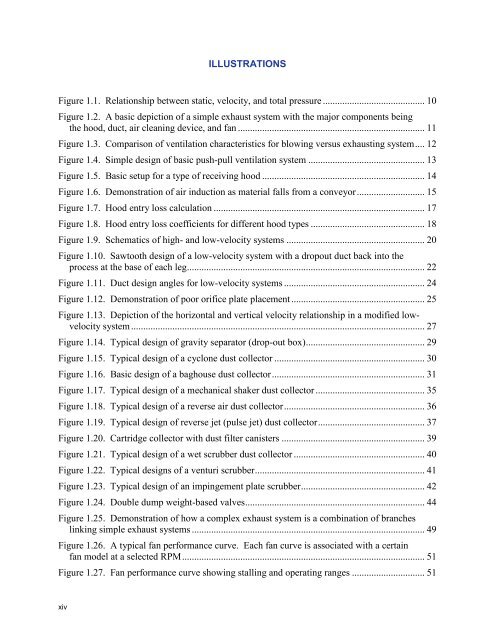Dust Control Handbook for Industrial Minerals Mining and Processing
Dust Control Handbook for Industrial Minerals Mining and Processing
Dust Control Handbook for Industrial Minerals Mining and Processing
Create successful ePaper yourself
Turn your PDF publications into a flip-book with our unique Google optimized e-Paper software.
ILLUSTRATIONSFigure 1.1. Relationship between static, velocity, <strong>and</strong> total pressure .......................................... 10Figure 1.2. A basic depiction of a simple exhaust system with the major components beingthe hood, duct, air cleaning device, <strong>and</strong> fan ............................................................................. 11Figure 1.3. Comparison of ventilation characteristics <strong>for</strong> blowing versus exhausting system .... 12Figure 1.4. Simple design of basic push-pull ventilation system ................................................ 13Figure 1.5. Basic setup <strong>for</strong> a type of receiving hood ................................................................... 14Figure 1.6. Demonstration of air induction as material falls from a conveyor ............................ 15Figure 1.7. Hood entry loss calculation ....................................................................................... 17Figure 1.8. Hood entry loss coefficients <strong>for</strong> different hood types ............................................... 18Figure 1.9. Schematics of high- <strong>and</strong> low-velocity systems ......................................................... 20Figure 1.10. Sawtooth design of a low-velocity system with a dropout duct back into theprocess at the base of each leg .................................................................................................. 22Figure 1.11. Duct design angles <strong>for</strong> low-velocity systems .......................................................... 24Figure 1.12. Demonstration of poor orifice plate placement ....................................................... 25Figure 1.13. Depiction of the horizontal <strong>and</strong> vertical velocity relationship in a modified lowvelocitysystem ......................................................................................................................... 27Figure 1.14. Typical design of gravity separator (drop-out box) ................................................. 29Figure 1.15. Typical design of a cyclone dust collector .............................................................. 30Figure 1.16. Basic design of a baghouse dust collector ............................................................... 31Figure 1.17. Typical design of a mechanical shaker dust collector ............................................. 35Figure 1.18. Typical design of a reverse air dust collector .......................................................... 36Figure 1.19. Typical design of reverse jet (pulse jet) dust collector ............................................ 37Figure 1.20. Cartridge collector with dust filter canisters ........................................................... 39Figure 1.21. Typical design of a wet scrubber dust collector ...................................................... 40Figure 1.22. Typical designs of a venturi scrubber ...................................................................... 41Figure 1.23. Typical design of an impingement plate scrubber ................................................... 42Figure 1.24. Double dump weight-based valves .......................................................................... 44Figure 1.25. Demonstration of how a complex exhaust system is a combination of brancheslinking simple exhaust systems ................................................................................................ 49Figure 1.26. A typical fan per<strong>for</strong>mance curve. Each fan curve is associated with a certainfan model at a selected RPM .................................................................................................... 51Figure 1.27. Fan per<strong>for</strong>mance curve showing stalling <strong>and</strong> operating ranges .............................. 51xiv

















